How to start a Blog in 2021?
What is a blog?
A blog is a discussion or informational website published on the World Wide Web consisting of discrete, often informal diary-style text entries. Posts are typically displayed in reverse chronological order, so that the most recent post appears first, at the top of the web page.
How to start a blog?
- Step# 1:- select a perfect niche!
- Step# 2:- select a blogging platform
- Step# 3:- Pick a domain name
- Step# 4:- Get a web hosting account
- Step# 5:- starting a blog on WordPress
- Step# 6:- Select a theme and design your blog
- Step# 7:- Write and publish blog content
- Step# 8:- Optimize your blog content for Seo
A quick primer – Blogging for beginners
There are five main points you need to know for creating a blog quickly. We will focus on how to start a blog on WordPress later, but for now, it’s important that you review these steps. If you are familiar with these details, you can get a blog online in 20 minutes or less.
Picking a niche and a name
Your blog’s niche is the particular market (topic) you will be targeting. Choose a topic you are passionate about. Also, make sure your niche has enough interest around it and that people search for topics related to your niche.
When it comes to naming your blog, you have countless choices. You can use your own name, last name, or some combination of the two. Or, you can use a descriptive combination of words.
Selecting the best blogging platform
The next step is to find the best suited blogging site to start building your own blog. There is a wide selection of platforms with all kinds of different features.
I suggest using self-hosted WordPress blog software if you are serious about blogging.
Finding web hosting and a domain
A hosting company acts as the foundation for blogs. Selecting the wrong web host can ruin your hopes of running a successful blog.
A domain name is the name by which your blog will be known online, no matter what niche you choose. It’s a unique web address on the Internet.
Designing and maintaining a blog
These days, you don’t have to be a professional web designer or developer to make your blog look beautiful!
Platforms like WordPress.org come with many pre-designed free blog themes. Once you install WordPress you can choose templates, based on your preferred layout and color scheme.
Reading useful resources
Starting a blog is your first step in entering the blogging world. However, to be successful online and make money, you have to learn more.
Once you select a niche, I also suggest you validate it. Below is a 3-step formula to confirm your niche for success.
Step #1: Select a perfect niche for your blog
To start a blog and make it as a blogger, you have to select the right niche for your blog.
- First, make sure to pick a niche that you are the most interested in—the one you are passionate about.
- Second, you need to make sure a niche has enough audience interest—topics people searching for.
That way you will follow your passion, find your readers, and enjoy your blogging journey.
A 3-step blog success validation process:
- Check niche size.
- Explore competitors.
- Analyze monetization potential.
This process will help you obtain a clear idea of the size, competition, and monetization potential for your proposed niche. If you are not sure how to select and validate a blog’s niche, read our detailed guide.
Step #2: Choose a blogging platform
At this stage, you’ll need to look at the available blogging platforms out there and determine the type of blog management software that you are going to use.
I recommend building your blog using the self-hosted WordPress blog setup that I share in this guide.
When it comes to blogging sites, you have a few options. Below are usage statistics showing the distribution of blog technologies in the United States.
WordPress software is by far the most popular technology with a 90%+ market share in the U.S.
Let’s look at the top 3 solutions and I’ll explain the main difference between them.
Self-hosted blog solutions (e.g. WordPress.org)
You don’t have many choices when it comes to self-hosted blogging systems (also called a Content Management System or CMS). As you can see from the graph, the most popular is the free and open-source system WordPress.org.
Self-hosted platforms allow you to set up your blog and run it using your own domain and web hosting. You’re fully in charge of your blog and its contents. It will cost just a few dollars per month for the webspace (hosting account), and around ten dollars per year for a domain. The actual blogging software is free.
If you want total control of your blog, or plan to run ads, sell products and services via your blog, then this is the best way to go.
Hosted blog solutions (e.g. Blogger and Tumblr)
For many new bloggers, it’s tempting to start a blog using free hosted platforms such as Blogger.com or Tumblr.com.
However, it’s important to understand that “free” always comes with limitations.
- First, your blog name will be set as a subdomain (examples: yourblog.blogspot.com or yourblog.tumblr.com).
- Second, you’ll be subject to their rules and restrictions.
Free options come in handy for testing a blogging platform. But, if you’re serious about starting a blog, you’ll have to start paying for full services and a custom domain name sooner or later.
How much does it cost to start a blog?
Below are the costs of a 1-year basic hosting plan with a custom domain name to install wordpress.org For hosting services, I will show the Bluehost company’s pricing plans. If you decide to use another service, prices will vary but it shouldn’t be more than $100 per year.
How much does it cost to start blogging with Bluehost?
Blue host is one of the best in business provide at the time being and they serve different packages.
- Their package 3 offers. It starts at only $3.95/month.
- they have free stuff such as:-
- The free domain name for 1st year
- Free SSL certification Included
- 1 click WordPress install
- 24/7 support
 press the image to get a special promo discount!
press the image to get a special promo discount!
To make your blog using WordPress.org, you need to decide on two important things: a domain name and a web hosting company. If you are a new blogger, you should try using Bluehost, a company that powers over 2 million websites worldwide.
I was able to negotiate a special deal only for our visitors that includes:
- Free domain name.
- Discount price of $2.75/month.
- 30-day money-back guarantee period.
- Set up a blog with a one-click install.
The other domain name and hosting provider is Hostgator.com
This one is better for starters because it's more cheaper and has a lot of free stuffs when you purchaseone of their product.- Free 1 year domain registration
- one-click WordPress install
- free Hostgator website builder
- unmetered bandwidth and disk space
- 45-day money-back guarantee
- Free SSL certification
- $150 worth of google ads spend credit
- $100 worth of being ads credit
- free email
- FREE MySQL transfer & script transfer and 24/7/365 support
Claim your 55% off promo using this link
Step #3: Pick a domain name
Your domain name will be the name by which you will be known online, no matter what niche you choose. It’s your blog’s unique address on the Internet. It will be yours as long as you continue paying the annual fee ($10 to $15 per year for a .com).
Users who know your domain (URL – uniform resource locator) can simply type it into their browser’s address bar. Others will be able to discover you through search engines such as Google and Bing, so you definitely need to find a unique blog name.
Your domain name may be the highly popular “dot com”, or it may be country or niche-specific. The general rule is to get a “dot com” domain, but some of the other extensions can be used too. For example, “dot net” or “dot blog”.
If you can’t find a domain name you like, Bluehost will let you choose one later. That will give you time to do some research and thinking before you start your blog.
Step #4: Get a web hosting account
After choosing a domain name, selecting a reliable hosting service will be one of the most important decisions you make.
To a great extent, the functionality and performance of your site will depend on your blog hosting. The host makes sure your blog is available 24/7 to potential readers and it’s where your contents and files are stored online.
Most hosting companies will also provide you a free domain for the first year when you buy their services.
The wrong web host can cause many problems with your blog. Just imagine choosing a mobile company that has no reception. Your web host is a major piece of the puzzle to creating a blog that is well-functioning. Therefore, you must choose a reliable provider.
Based on my research and information available on the official WordPress website, Bluehost is a top choice in the opinion of many blogging experts.
This section provides detailed information to help you sign up for your web hosting account and install WordPress software. As an example, I will show you how to create a blog with Bluehost. I have included screenshots of the pages that you need to go through.
1. Visit the Bluehost homepage
 then press the green get started button.
then press the green get started button.
2. Select your hosting plan
You will start by picking a hosting plan. If this is your very first blog, you can go with the Basic plan. Later, you can easily upgrade to a Plus or Choice Plus plan once your blog starts growing. Explore what each plan offers, e.g. Choice Plus plan comes with Domain Privacy and some extras. If your budget allows, go with the recommended plan.
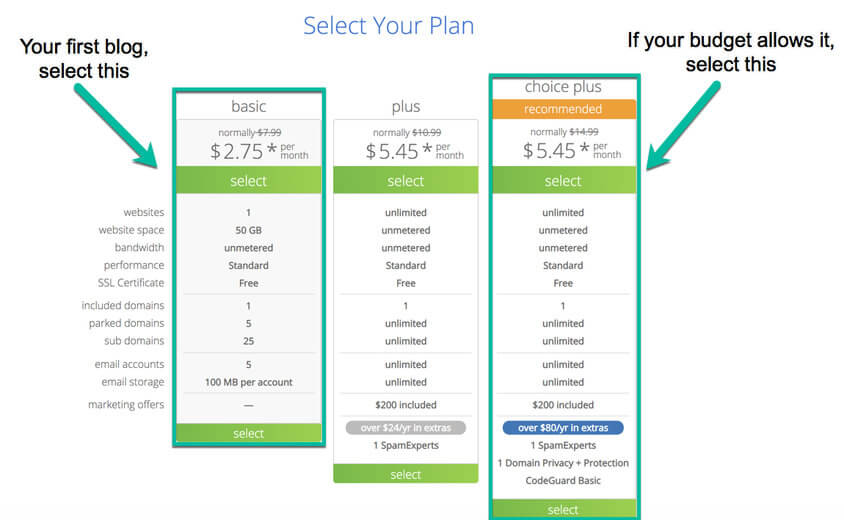
3. Set up your domain name
Your domain name will be your blog’s address, so you should take your time to come up with something unique and memorable. Just type in the desired name in this “new domain” box and Bluehost will show you whether it’s available or not. If not, it will provide you with a list of similar names to choose from.
Don’t worry if you can’t find a good name right away, you can skip this step and pick a domain name once you start a blog.
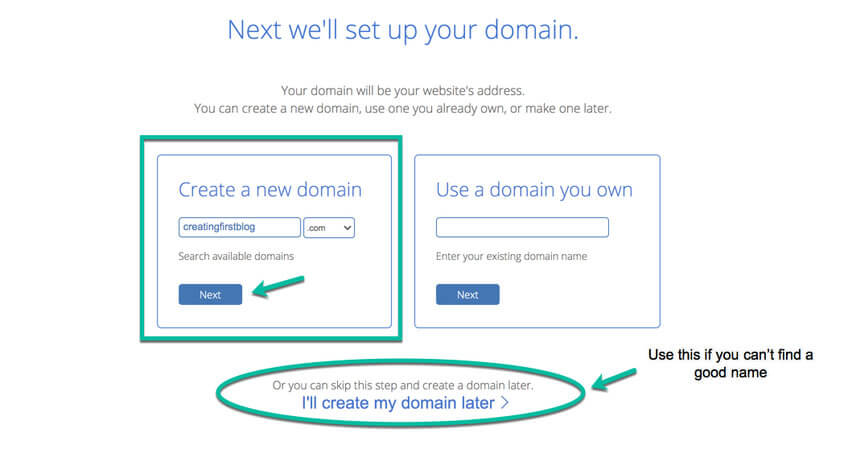
If you have already purchased a domain name somewhere else, you can use that name. Just type it into the “Use a domain you own” box.
4. Register with Bluehost
After you choose your domain name, Bluehost will take you to the registration page where you can fill in your personal info manually, or you can Sign in with your Google account to make the process even easier!
Add your account information
Start by filling out your personal information.
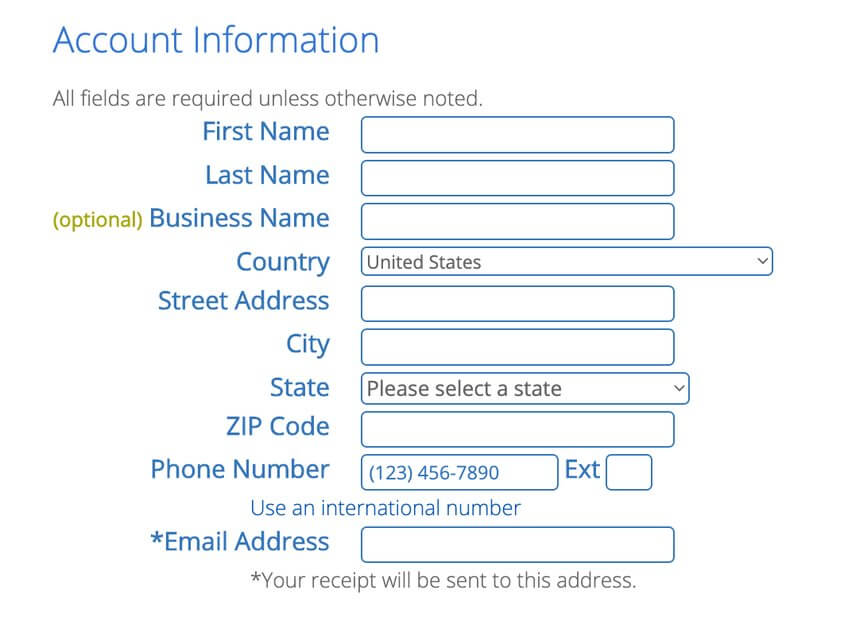
Select your hosting package
At this point, it’s time to select an account plan from the available options. Bluehost offers 12, 24, and 36-month packages.
With a 12-month package, you will have to pay a lower amount up front, but with the other two packages, you will get a better deal if you are ready for a longer-term commitment.
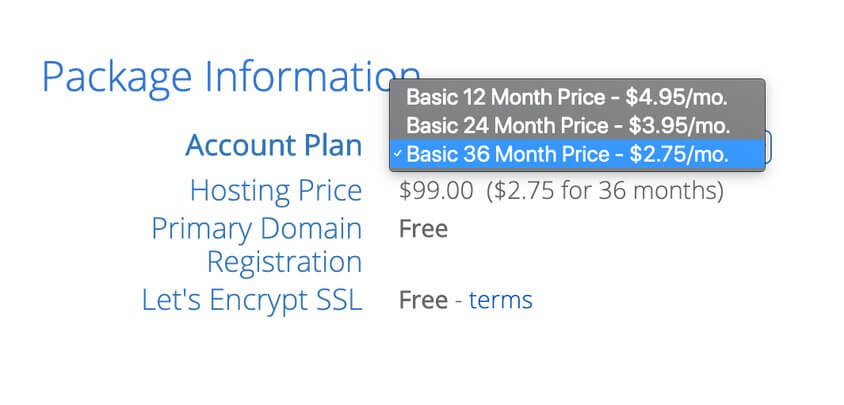
Package extras
Review your package extras carefully. Not every extra is essential, and by unchecking the boxes of extras you don’t need, your total amount owing will decrease.
You can always add extras later if you find that you need them. I do suggest that you keep the Domain Privacy Protection box checked. This service will hide your personal contact information from the global database, which is publicly visible to anyone on the internet.
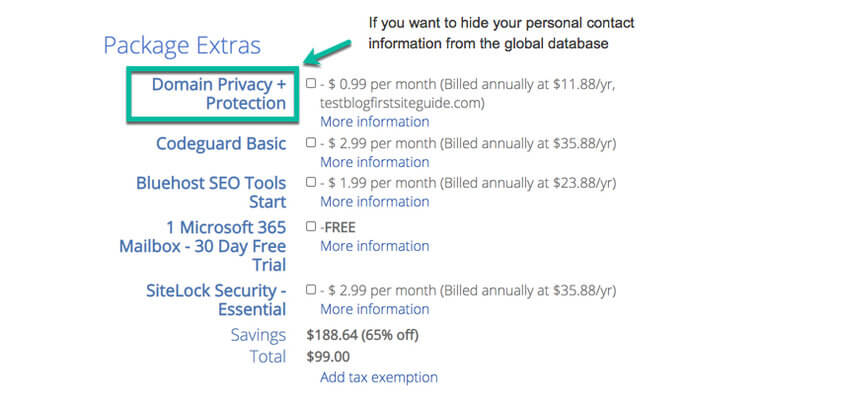
Payment information
Now, enter your payment information. Check the box that you have read and agree to the TOS (Terms of Service), and click on the green “Submit” button.

Bluehost will send you a confirmation email when the payment goes through. You will also receive an email to verify your email address to activate your domain name.
Next, you will set up the Bluehost account. You are one step closer to starting a blog!
5. Create your account
Let’s create your account with Bluehost.
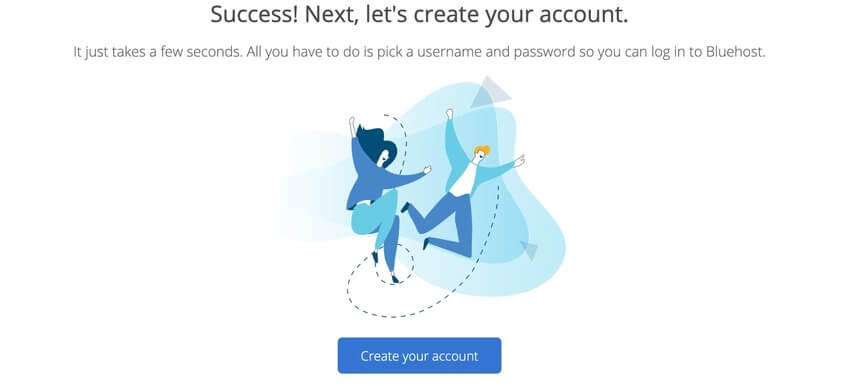
- Step 1. Click the “Create your account” button.
- Step 2. Enter your password and complete the account set up.
- Step 3. Your account is ready to go. Click the “Go to login” button.
- Step 4. Fill in the fields “Email or Domain Name” and “Password”.
You are all set. Next, you will start working on creating your blog.
6. Create your WordPress blog with Bluehost
After you log in to the account, Bluehost will offer a 4-step process to help you create a blog. I suggest you go with that procedure if this is your first time starting a blog.
You can also click the “Skip this step” button and work on blog formation from scratch on your own inside the Bluehost hosting account.
Four steps blog set up assistance process:
- Step 1. You will start the process by answering 3 questions: What kind of site? What type is it? And who is it for? In my example, I selected: Blog, Personal, Myself. You can select the same choices or pick what fits your individual case.

- Step 2. With this step, you can pick what else would you like to add on your site. Bluehost gives you a few options to choose from.
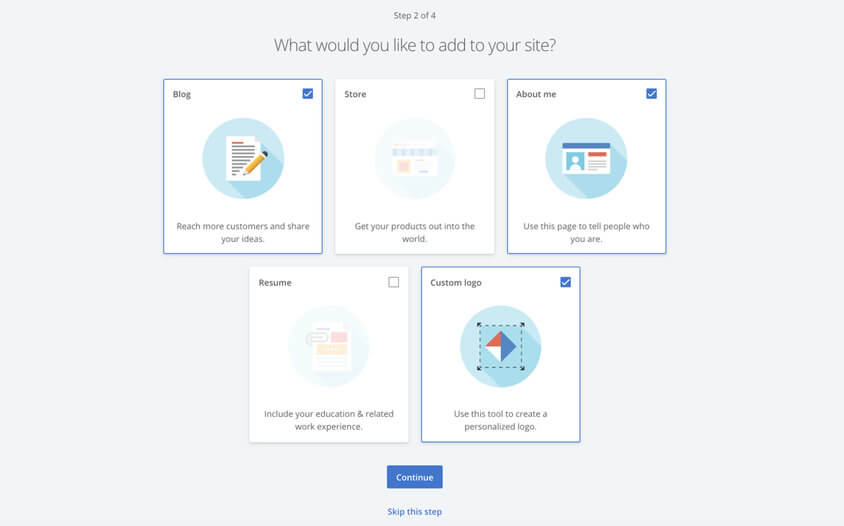
- Step 3. In this step, you need to answer a few questions such as the name of your blog, tagline, and how comfortable you are with creating websites. Note, you can always change this later.
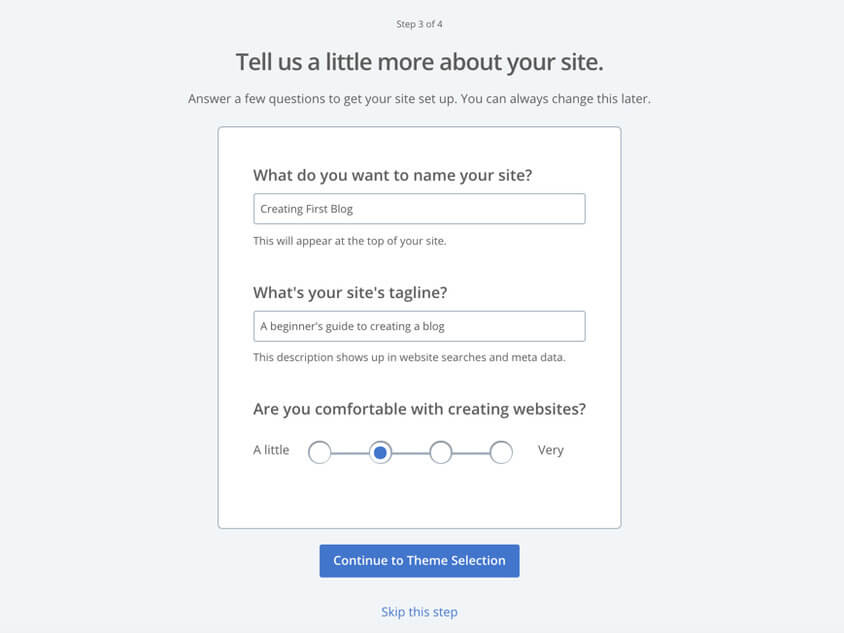
- Step 4. Check out the chosen themes by Bluehost and see if you like any of them (if you don’t see a theme you like, skip this step). You can always change it and use a different one later. More information on this further on.
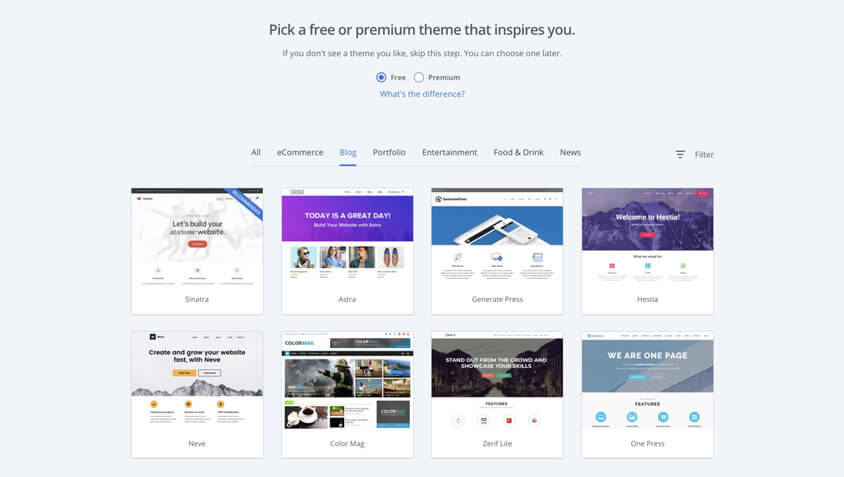
Once you complete setting up your blog with these 4 steps you will be taken to your Bluehost account page. At this point, the WordPress software is installed and your blog structure is set up!
7. Launch your blog
Inside your Bluehost account, you will see options to further customize your WordPress blog site based on Bluehost’s recommendations. These options are here for you to do some pre-launch customization to your blog.
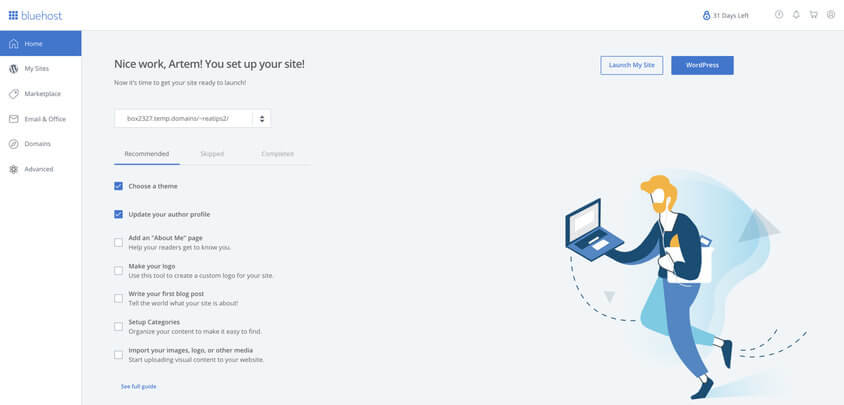
After you click the “Launch My Site” button, your blog will go live!
If you open your website in a web browser don’t get frustrated if it doesn’t look quite right. It is just the first draft. Inside the WordPress dashboard, you will have to apply a few changes and add content to make it look polished and complete. I will show you how later!
You can access the WordPress blog dashboard from your Bluehost account by clicking the blue “WordPress” button in the top right corner of your screen.
Did you start a blog yet? → Click Here to Get Started
Next, as promised, I’ll show you how to find the right theme for you, and how to customize your blog.
Step #6: Select a theme and design your blog
The first thing your blog needs is a face (design and layout).
Installing a new WordPress theme is exciting and fairly straightforward.
Inside the WordPress dashboard, under the “Appearance” tab, click “Themes”. You will be presented with some popular options. You can click on the WordPress.org Themes button and search for free themes. There are more than three thousand themes available on WordPress.org.
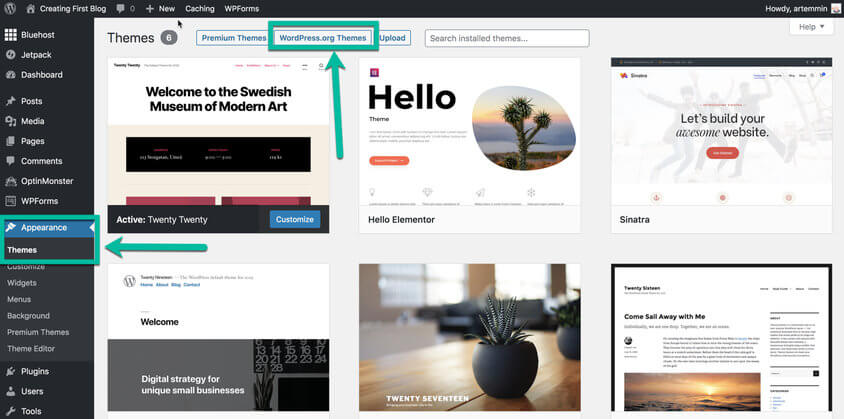
The look and feel of your new blog rely on the theme you choose. Your first-time readers will notice the overall appearance of it before they even take a look at the content. Select a theme that looks great, but also works for your specific needs.
Here’s a quick guide for choosing your theme by searching within the WordPress dashboard:
- Read the description – Most themes come with a short description of features and functionality. Reading it can help you to figure out if the theme matches your needs.
- Preview the theme – Preview the theme (demo) to get an idea of the overall look, layout, and how customizable it is.
- Check the ratings – Star ratings will be visible in the preview and under theme details to give you a clear idea of how good the theme is.
If you can’t find a theme that you absolutely love, don’t worry. Settle on one that you like, and you can always change it in the future.
Once you install a theme, don’t be surprised if it still doesn’t look quite right. It is just a skeleton of a blog. To make it appealing, you’ll have to fill it in with content (text, photos, videos, etc.).
Should you choose a free or premium theme?
In my opinion, there are more than enough free WordPress themes to choose from for any blog topic.
If you don’t feel like searching through thousands of themes, you can easily start things off with either Twenty Twenty or Twenty Twelve themes. Both free themes are presented by WordPress.org and are popular with creators.
Remember, you can always pick a different theme later as you continue setting your blog. All of the pages and unique content that you create will be transferred automatically to a new theme layout.
If the current stash of free themes does not satisfy your particular desire, you can check the available premium themes. These themes are usually designed by third party companies and sold on different WordPress theme sites. The price range for single-use licenses ranges from $30 to $500, depending on which premium theme you choose.
Blog theme customization
Remember, your WordPress dashboard is the back end location where you will manage your new blog. It provides you with fast access to all of the tools you need to add content and fine-tune your blog functionality for the ultimate user experience. Your first step towards mastering WordPress is learning the dashboard.
WordPress has unlimited customization options so it’s impossible to cover everything in this “How to start a blog” guide. Instead, I’ll cover the first most important changes you should apply to your blog. For this example, I’ll be using the Twenty Twenty theme.
Make your blog’s logo
Inside your Bluehost account, you can find the “Make your logo” tool. If you didn’t do it yet while launching your blog, now is the time to get it done.
Once you click the checkbox, you will be taken to an AI-powered logo maker. It’s an easy to use tool that you can use to create a beautiful logo for your blog in seconds. Start by entering a name and slogan (if you have one), the tool will automatically generate different types of logos.
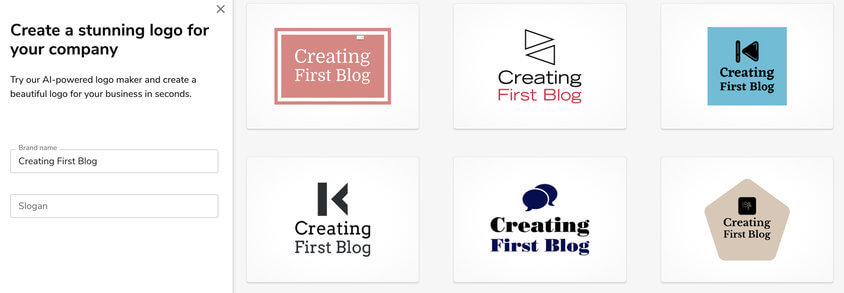
Select one logo you like the most, click on it, and further customize it according to your taste.
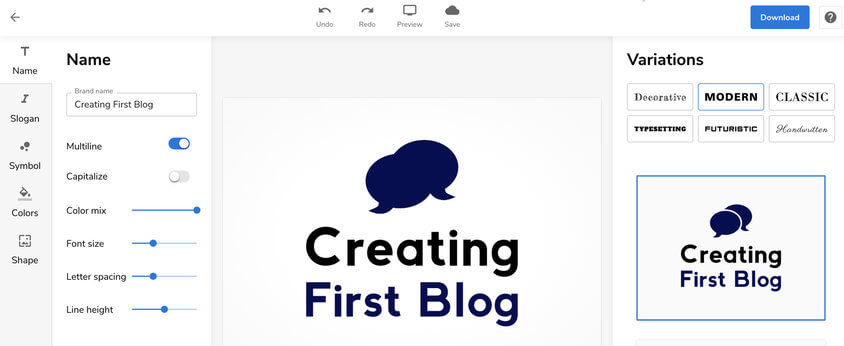
When you are done with your logo design, click the Download button and a new page will show up with your logo files ready to be saved to your computer.
Customize your blog
Now, let me show you where you can do general customizations of your blog. That includes: uploading the logo you just created (or will create in the future), editing the blog title and tagline, changing colors, uploading the background image, and making homepage settings changes.
As I’ve mentioned, I’ll be showing you how to apply these changes to the Twenty Twenty theme. If you picked a different theme the process could be slightly different. However, in most cases, all themes have similar customization options.
To start optimizing your blog, go to the WordPress admin dashboard. Locate the Appearance tab on the left-hand side and choose the Customize option.
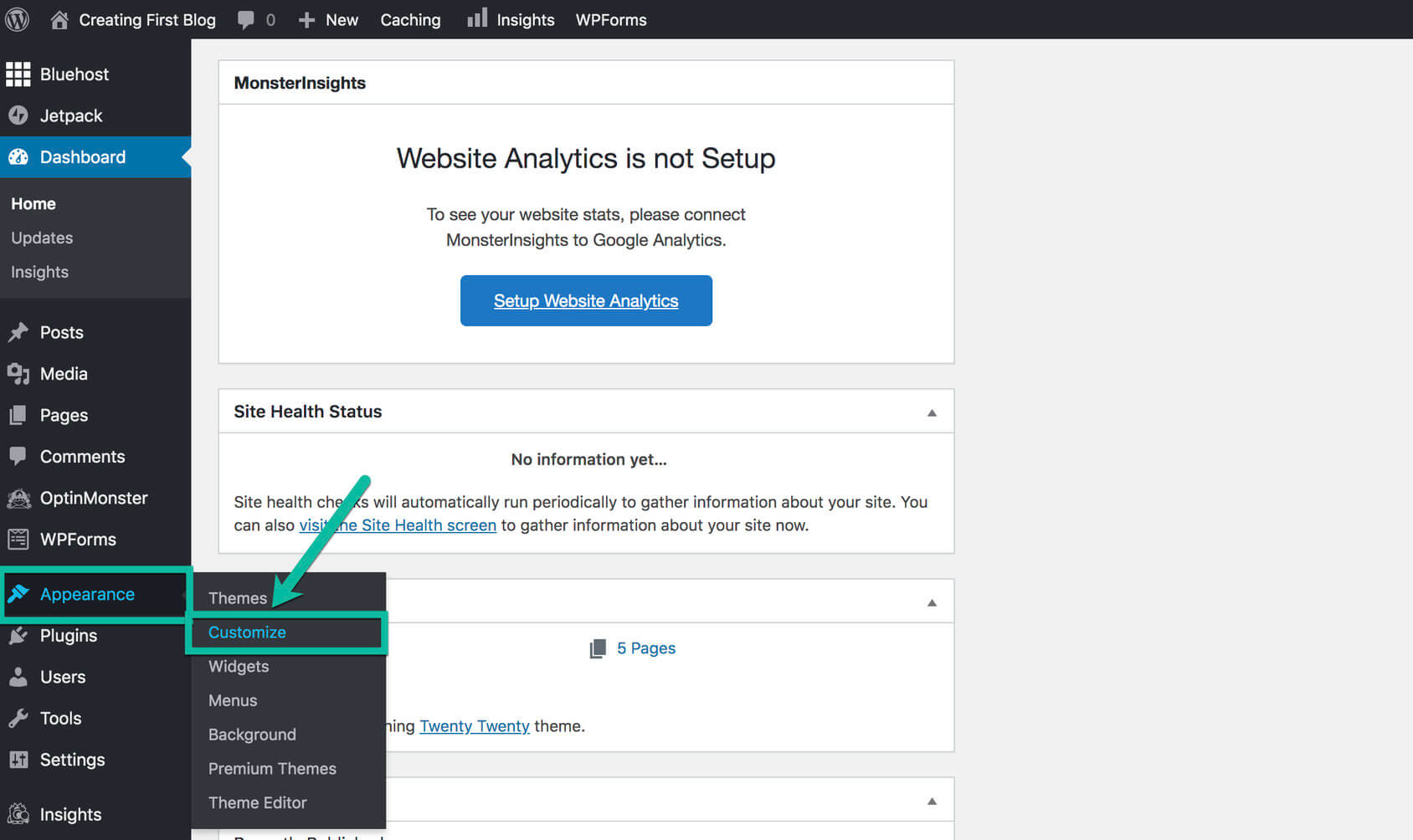
Each WordPress theme will customize a little differently. In my case, I’ll show you the customize options for the Twenty Twenty theme.
On the left-hand side, you will see the following Customizing menu options:
- Site identity – Upload your logo, change site title and tagline, and upload site icon.
- Colors – Change your blog’s background color, header and footer colors, and customize the primary color.
- Theme options – Select if you want to show a search icon in the header of your blog and show an author bio for your posts.
- Cover template – Make additional changes to the page template such as the overlay background color, overlay text color, and overlay opacity.
- Background image – Upload any custom background image you want to start using on your blog.
- Menus – Customize your blog’s menu, social media menu links, and change locations where they are displayed.
- Widgets – Customize your footer, add a description, and how to find you if you have a physical location.
- Homepage settings – Choose what’s displayed on the homepage of a blog. It can be the latest blog posts or a static page.
- Additional CSS – Add your own CSS code to customize the appearance and layout of your site (advanced option).
You can also check how your blog looks on different devices by using the menu at the bottom with three icons: desktop, tablet, and mobile devices.
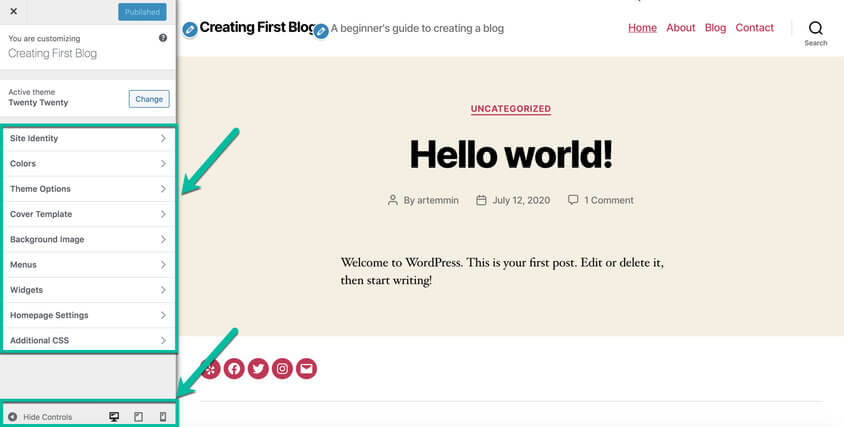
Many themes (e.g. the Twenty Twenty theme) come with the new Gutenberg editor that revolutionizes the way users build pages and write posts inside WordPress.
Gutenberg is a visual editor that works on a blocks principle. So, when you decide to add a new paragraph, heading, image, video, or anything else, there are blocks you can quickly add to new pages or blog posts.
This way, creating blog content is much easier for beginners, whether you’re building a landing page or writing a new article. Blocks can be rearranged into a layout you like, and they’re here to make your life easier.
Add plugins to your blog
Plugins are bundled pieces of code which affect the way your site looks and functions. They can add new functionality to your WordPress blog, extend your theme’s capabilities, and personalize a blog as a whole or in part.
While the majority of plugins are free, there are many that are offered for a fee, based on their unique functionality. At the moment, WordPress.org has more than 57,000 different plugins in the repository.
By default, when you set up your blog, Bluehost will automatically add some plugins they think are important for any website. You can review these plugins inside the WordPress dashboard and add new ones by clicking the Plugins tab on the left-hand side.
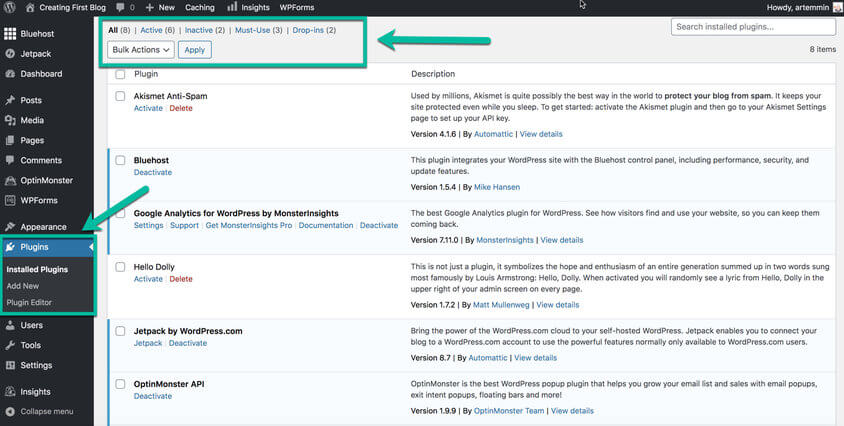
Here you can install new plugins, deactivate, delete, and update them.
Below, I’ll show you some suggested plugins that you should be using.
List of recommended plugins for bloggers
To save you time, I’ve selected some important plugins (free) for your immediate blogging platform needs:
- MonsterInsights – Google Analytics plugin for WordPress, to monitor and analyze your website traffic.
- Yoast SEO – A comprehensive SEO plugin for your blog, to optimize your content for search engines.
- WP Super Cache – Helps with the load time of your WordPress blog and delivers content to your readers faster.
- Akismet – Protects your comments and contact form from spam and prevents your site from publishing malicious content.
- Contact Form 7 – A contact form with flexible email options. It supports CAPTCHA and Akismet spam filtering.
- Disqus – An alternative to the basic WordPress comment system with advanced administrative and comment capabilities.
- YARPP – Creates a related blog posts list at the end of each piece of content automatically to encourage people to continue browsing your site.
Congratulations, you just learned how to customize your blog and make design changes!
The next step is to learn how to write content for your blog.
Step #7: Write and publish blog content
So far, you’ve established a domain name, chosen your blog hosting site, set up a blog theme, and you are ready to go. Your framework is complete.
Now comes the moment of truth and you can actually start blogging. You need to learn how to write your first blog post. On the web, any useful information that you share with readers is called “content.” It must be something valuable that people will want to interact with and come back for more.
WordPress CMS is structured in a way that you can publish your content as Posts or Pages.
Before you begin publishing posts (day-to-day writing) on your blog make sure you fill in all the important static pages with content (such as About us, Contact, etc.). Let’s explore those types of pages.
Prepare and publish content on main pages
Depending on your individual needs you can decide what pages to publish. The following are the most common pages bloggers use:
- Homepage – This depends on what type of layout you choose. As I described above, when customizing your blog you can choose to display the homepage as a static page. In that case, you will have to prepare content for it.
- About us – The most traditional page on any blog is the “About us” page. This page tells new visitors what it is all about, who you are and why you run a blog about your niche topic.
- Contact – This page allows visitors to your blog to communicate with you. It can be a straightforward page with your email address plus your social network links, or you can use a simple contact form that visitors can use to communicate with you.
- Products, Services, Resources – Static landing pages with any additional information that you want to include on your blog.
The guidelines to publish a new WordPress page:
A blog page provides static content or information to the readers. Standard pages that bloggers use include: About, Contacts, Products, or Services. A page also can be a cornerstone (or evergreen) content with information that continues to be relevant to its readers. For example, this guide you are reading right now.
- To create a blog page in WordPress, log in to your dashboard admin area using your login details (username and password).
- Hover your cursor over the “Pages” menu item on the navigation menu located on the left-hand side of the Dashboard. Click “Add New”.
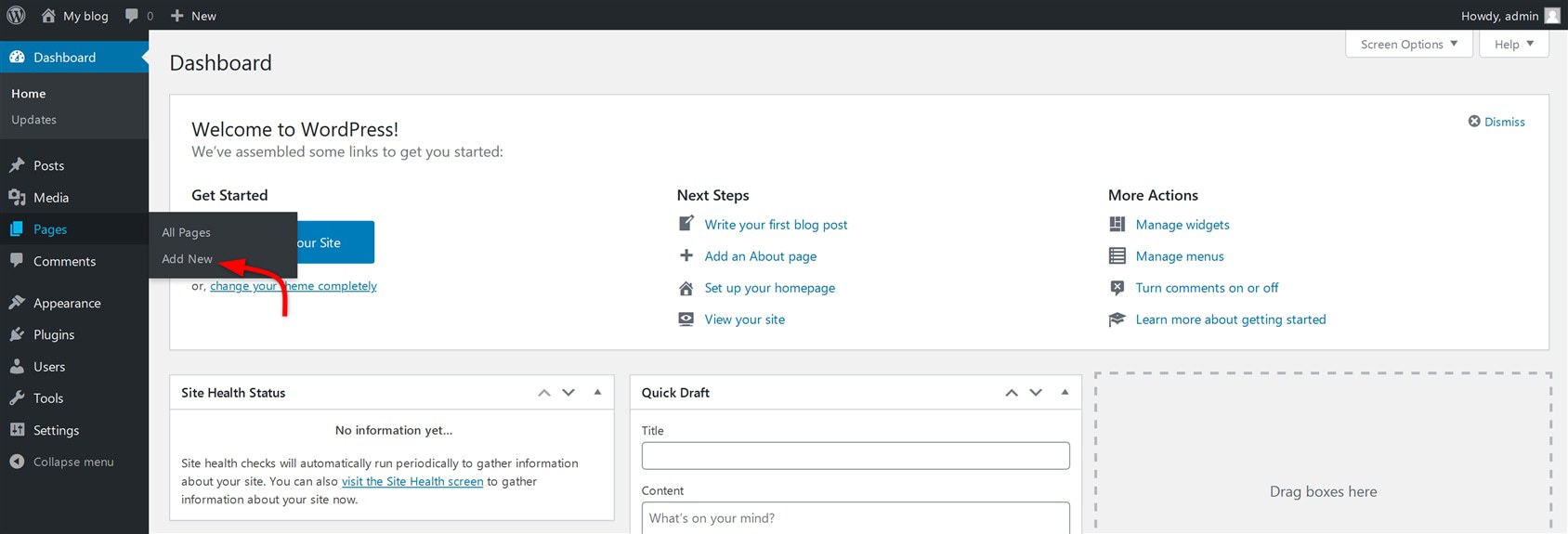
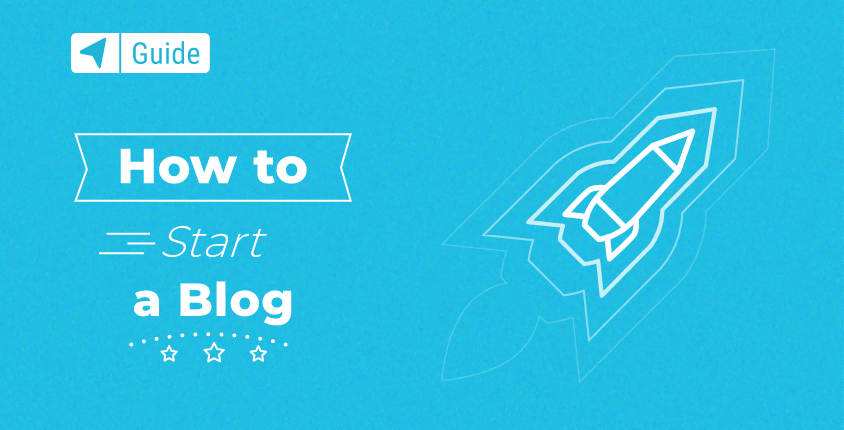
Do you want to learn how to start a blog?
Hi there, my name is Anya. I’ve been blogging for more than eight years and I love every moment of it. Blogging helped me to find my first job and continues to be my lucrative side-gig.
In 2010 when I was learning how to create a blog, I spent a lot of time searching for helpful information online. I was only able to find it piece by piece on a variety of websites. To save you time, I’ve created this free step-by-step blog tutorial to teach beginners how to make a blog quickly and easily is a free resource that is 100% supported by readers.
Disclosure: If you purchase products through links on our site (e.g. Bluehost services), we may earn a commission. It comes at no extra cost for you but it helps us to create more useful content.







2 Comments
What do you prefer in your opinion and self experience blue host or host gator?
ReplyDeleteI would like to say blue host, is better!
Delete